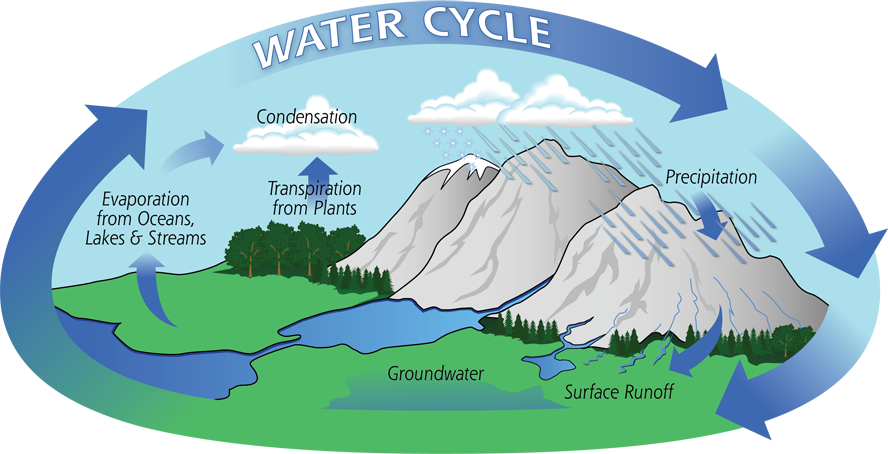GPM Anime Contest Webquest Part 1: Water Cycle

So, are you thinking about creating an anime mascot for GPM? Do you need to learn a little more about the science and technology behind measuring precipitation?
Here is a webquest to help you explore more information about the water cycle, weather and climate, technology, and societal application of the GPM mission.
Part 1: The Water Cycle
Precipitation is a vital component of how water moves through Earth’s water cycle, connecting the ocean, land and atmosphere. Water evaporates from the surface of the land and oceans, rises and cools, condenses into rain or snow, and falls again to the surface as precipitation. The water falling on land collects in rivers and lakes, soil, and porous layers of rock, and much of it flows back into the oceans. The cycling of water in and out of the atmosphere is a significant aspect of the weather patterns on Earth.
Scientists study how precipitation moves around the world, how much it rains in local areas, and what kind of rain or snow falls - is it heavy rain from a storm or a just a drizzle? They use what they learn to understand how precipitation impacts streams and rivers, water flowing across the surface of the ground, and groundwater. GPM's frequent and detailed measurements are part of what scientists use to make models of the Earth's water cycle so they can see how it is changing.
Let’s begin by following a molecule of water as it makes its way through the water cycle in this short animation: http://pmm.nasa.gov/education/videos/tour-water-cycle
Now that you have the feel for how water is able to move through the land, the air, and the oceans, let’s learn more about how it is able to distribute both water and heat as it moves through the water cycle: http://pmm.nasa.gov/education/videos/earths-water-cycle
The ocean is vital for moving both water and heat energy through the water cycle. You can see how at this NASA website: http://pmm.nasa.gov/education/videos/water-cycle-heating-ocean.
Here you will see actual NASA data sets that have been put into animations and positioned on a globe to help you visualize how solar energy drives the water cycle.
The next website will focus on how evaporation and winds combine to move water from oceans to land. It shows how Earth’s systems interact with each other with actual data: http://pmm.nasa.gov/education/videos/water-cycle-steaming-air
As you interact with this information, consider these questions:
- Why don’t the oceans simply reabsorb the water that evaporates?
- Why does more water evaporate off of oceans than off of land?
- About how long does water vapor remain in the air?
We know that almost everything needs freshwater to survive. Did you also know that we use freshwater to generate electricity, make computer chips, and to produce most of the items we use on a daily basis? Go to this site and poke around to learn more about what freshwater is used for in our everyday lives. You can find out how much water is used in your state as well as find out more about the water in the area that you live in. This data is only available for the United States on this website: http://www.epa.gov/WaterSense/our_water/water_use_today.html
To finish off this portion of the webquest, sit back and enjoy this video that sums up many of the content you focused on in this section: http://pmm-dev.pps.eosdis.nasa.gov/education/videos/water-water-everywhere
Now see if you can answer these questions about the water cycle!
- How will GPM’s frequent and detailed measurements help us better understand the water cycle?
- What is the primary energy source that drives the water cycle?
- How does precipitation connect Earth’s land, ocean and atmosphere?
-
Other than needing freshwater to drink and grow crops, what other functions does freshwater serve in the modern world?
Continue to Part 2: Weather & Climate
NASA GPM
NASA GPM


